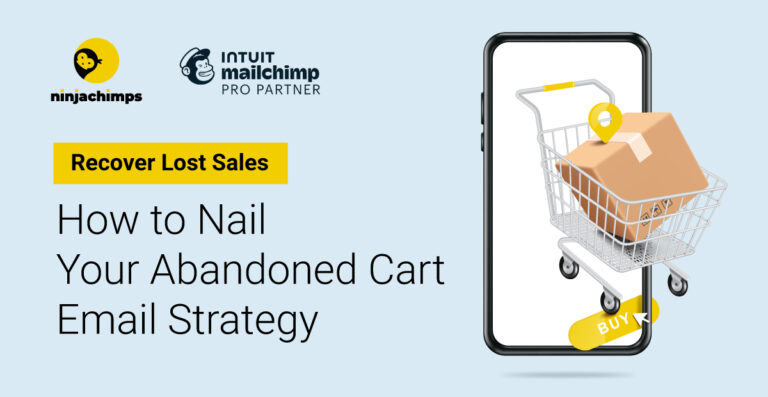Recover Lost Sales: How to Nail Your Abandoned Cart Email Strategy
Every hour, retail businesses across Australia watch would-be customers slip away, leaving as much as 70% of shopping carts behind. That lost revenue doesn’t need to stay lost. A well-timed, well-crafted abandoned cart email sequence can turn hesitation into completed purchases and transform your bottom line.
Mailchimp’s advanced toolset makes this turnaround simple. Its automated triggers, dynamic product blocks, and real-time analytics help you create abandoned cart emails that feel personal, arrive at the perfect moment, and drive shoppers back to checkout. Brands like Huckberry have seen conversion spikes of up to 10% using similar tactics—proof that strategic, data-driven recovery emails don’t just recoup revenue; they build lasting customer trust.
Let’s unpack the impact of cart abandonment and the opportunities waiting in every forgotten cart.

Understanding the Impact of Cart Abandonment
Cart abandonment isn’t a fringe problem—it’s the retail norm. Research reveals that approximately 70% of online shopping carts are left behind, costing retailers millions in unrealised revenue. During peak sale periods or holidays, the scale of lost sales is staggering.
Why do customers hesitate? The main culprits include:
- Unexpected shipping costs or taxes
- Slow delivery estimates
- Lengthy checkout processes
- Concerns about payment security
- Lack of preferred payment methods
- Everyday distractions
Without a recovery strategy, Shopify data shows merchants reclaim only 3.33% of lost sales. However, retailers who use abandonment emails see open rates of 49%, click-through rates of 9%, and conversion rates of 8%—proving that strategic follow-up works.
Every abandoned cart email is a chance to reclaim revenue and build customer trust. Here’s how Mailchimp makes it possible.
Leveraging Mailchimp for High-Converting Abandoned Cart Emails
Mailchimp automates recovery with abandoned cart triggers, sending tailored emails or sequences when customers leave without paying. Its standout features include:
- Easy-to-build workflows for multi-email sequences
- Dynamic product blocks showcasing cart contents
- Behavioural segmentation for targeted outreach
- A/B testing and AI-powered subject line recommendations
- Real-time revenue reporting to track results
A global fashion retailer used Mailchimp to send a three-email sequence—reminder, urgency, and final discount—and recovered double-digit revenue within 30 days. That same framework is available to your store.
Setting Up Mailchimp’s Abandoned Cart Automation
- Connect your e-commerce platform (e.g., Shopify) to Mailchimp.
- Navigate to Automations → Customer Journeys, and choose “Recover Abandoned Cart.”
- Define triggers, such as one hour after abandonment.
- Add follow-ups at one-day and three-day intervals.
- Set exit conditions to stop emails once a purchase is completed.
Mailchimp allows flexibility, such as tailoring incentives by cart value or product category.
Designing Effective Abandoned Cart Emails in Mailchimp
Mailchimp’s templates make it easy to design visually appealing emails. Key tips include:
- Use dynamic product blocks for images and descriptions.
- Keep copy short and benefit-focused.
- Highlight a single, vibrant CTA button.
- Personalise with the customer’s name and tailored incentives.
- Add social proof, such as reviews or star ratings.
Testing different designs, tones, and offers with Mailchimp’s A/B tool can further refine your approach.
Best Practices for Abandoned Cart Email Campaigns
To maximise recovery rates, follow these best practices:
- Subject Lines: Use curiosity and urgency, such as “Did you forget something?” Keep it under 50 characters.
- Timing: Send the first email within one hour, followed by reminders at 24 and 72 hours.
- Incentives: Offer discounts, free shipping, or bundled upgrades to address cost hesitations.
- Social Proof: Include testimonials or real-time star ratings to build trust.
- Optimisation: Use A/B testing to refine subject lines, CTAs, and offers.
Mailchimp’s revenue dashboard helps track what works and pinpoint areas for improvement.
Maximising ROI with Advanced Mailchimp Strategies
Take your cart recovery efforts further with these advanced tactics:
- Segmentation: Group carts by value tiers and tailor incentives accordingly.
- Multi-Channel Follow-Up: Combine emails with SMS reminders for higher recovery rates.
- AI Tools: Use Mailchimp’s AI for subject line optimisation and on-brand visuals.
- Continuous Monitoring: Analyse performance weekly and iterate monthly for ongoing improvements.
Retailers who implement segmentation, SMS follow-ups, and AI tools have seen significant lifts in recovery revenue, proving the value of advanced strategies.
Take Your Cart Recovery Strategy to the Next Level
Abandoned carts aren’t lost causes—they’re opportunities. With Mailchimp’s automation, dynamic content, and AI-powered tools, you can recapture revenue, delight customers, and outpace competitors. Combining best-practice timing, persuasive design, and data-driven testing turns forgotten carts into repeat sales.
Ready to transform your cart recovery results? Contact Ninjachimps for a free consultation on optimising your abandoned cart email strategy, and start turning missed opportunities into measurable growth today.
